Bittersweet Culture and Growing FAQ
We frequently field questions regarding the planting, growing, and continued care of bittersweet both for home and commercial uses. The most common are listed here:
GENERAL:
Why do I need male and female plants? Bittersweet is dioecious. This means that male and female flowers are produced on separate plants. Both must be present, and within range, for pollination to take place. Female plants produce the berries. Rarely, a male plant will set a few, but never in abundance. Occasionally, a plant will be hermaphroditic, or partly dioecious . This means that flowers of both sexes are produced on the same plant. The berry set will never be as heavy, or as concentrated, as on a female plant. Autumn Revolution is an exception. It has a very heavy berry set and also bears very young.
What time of year is it best to plant? Spring and fall for field grown plants. Container grown plants can be planted anytime of the year that you can work the soil.
Do I have to provide a fence or trellis? It is best to do so. Although it can be trained as a semi-shrub, it is very difficult and requires a tremendous amount of time dedicated to frequent pruning and shaping. Bittersweet will, if not attended to, climb on just about anything that it can grab on to. These can be grown on the ground for erosion control and are quite effective. Just don’t plan on ever walking through this area without tripping.
Is Bittersweet poison? To a certain extent. For one thing, the berries are VERY BITTER. I can’t imagine anyone eating them as a snack. It is reported, though that they will make you sick if eaten. I know of no reports of a lethal ingestion. Birds, rabbits, and rodents will eat the berries as food. It does not bother them. House cats and dogs have been known to munch a little on the berries. Figure on cleaning up a not-too-pleasant mess if yours does.
How do I know that a packet of seeds has both male and female seeds in it? Plants from seed average 60% female to 40% male. There is no way, short of DNA testing, to know if a seed, or seedling, is male or female. If you should get a package of seeds that has all one sex plant produced, let me know. I want you to pick my Lottery numbers.
I have a plant that has sent up new stems from the root a foot away from the parent plant. Should I dig it for a transplant or will that injure the parent too much? Transplant it in early spring, before they leaf out. Then, expect more in the same spot. Sort of like mushrooms…………Actually, what causes this is a root injury. If a root over 1/8″ is severed or severely damaged, it will send up a shoot that will develop into the same sex as the parent plant. When removing these, it is not necessary to dig up more than a few inches of root with the new plant. Do not let them get overly large, or you will have a problem digging them up.
Should I mulch the plants? Yes. Both at planting and throughout their growth. This prevents weeds, conserves moisture, and keeps the ground cooler in hot weather.
Should I add a few more inches of mulch in the fall? OK if you do not have a rodent problem. Otherwise, you would be giving them a place to live.
What kind of mulch is best? Leaves, wood chips, grass clippings, straw, etc. Avoid sawdust or any leaves, wood chips, etc. from any Walnut species. It will kill the vines. Use other types of sawdust sparingly as well as wood chips. Here is why: The leaves, sawdust, and wood chips are largely carbon based and will tie up available nitrogen until they decompose, then release it back into the soil. Grass clippings, if fresh, contain a pretty good portion of nitrogen to help counter-act the amount of carbon in the clippings. Don’t use fresh grass clippings too deep. It can heat up to the point of combustion! Avoid using hay unless you enjoy weeding.
Sun or shade? Bittersweet in nature grows both in full sun, such as on fences, and as an understory plant at the edge of forests. Here it gets partial shade. In deep shade, it will get very leggy with wide spaces between leaf nodes and there will be little if any fruit production.
What Ph is best? Try to keep the Ph between 6.0 and 7.5 or certain elements can be tied up in the soil and unavailable to the plant. These are minors, but still important. They are Iron, Calcium, and Molybdenum. If the soil test kit does not include a test for Ph, then there is a slick little meter that is available for around $20.00 that you just stick in the ground and in a few minutes, it will give the Ph. No battery needed. Pretty accurate, too. Use lime if the soil is too acid (Ph low) or Aluminum sulfate or Sulphur if the Ph is too high (sweet, or alkaline).
PLANT SPACING:
How far apart should I plant my vines? At the farthest, 30 feet. At the closest, you can plant one male and one female in the same hole if short on space. Commercial spacing for production ranges from 12″ to 48″. A suggested spacing for just a few vines is 36″ for home use.
FERTILIZATION: Get a soil test kit! Don’t just slop on fertilizer! You want the same soil fertility as that required to grow garden beans. This will be listed on just about every home soil test kit. You don’t need to invest $$$ on a soil test kit for home use. Even the cheap ones are accurate enough for this.
Should I fertilize when planting? Only if a soil test shows abnormally low fertility, then only at 1/2 strength.
What fertilizer should I use? This also depends on your soil test. You want the nitrogen level to be correct for the plant. Too much N and the plants will grow wild with little fruit production. Too little N and they will just sit there. If you notice the leaves turning yellowish-light-green or yellow at the edges, then they are lacking in nitrogen. If growth is very lush, soft, and dark green, then there is too much nitrogen. Organic compost is always best. It is the most balanced. Be wary of municipal compost: The nitrogen level can be quite high if sewage sludge was used in the process. Otherwise, a good granular, water soluble, or time release is a good choice. Just match it to the soil test! Nitrogen (the “N”) is for leaf and vegetive growth. Phosphorus (the “P”) is for root growth. Potash (the “K”) is for blossom and fruit production. A balance is necessary! Too much, or too little can result in poor growth. More is not always better!
When should I fertilize again? Get a soil test kit and test for NPK levels. Too much nitrogen will result in few blooms.
Should I do an application heading into winter or wait until early spring? If the results of soil test show it is needed, then early spring is the best. Do NOT fertilize in late summer! The vines will put on a flush of soft growth that will not be hardened by winter and will be frost-damaged.
How often in the growing season should I put the fertilizer on the plant area? A couple of things need to balance: The balance can be tricky. Too much N and the plants will grow wild with little fruit production. Too little N and they will just sit there. If you notice the leaves turning yellowish-light-green or yellow at the edges, then they are lacking in nitrogen. If growth is very lush, soft, and dark green, then there is too much nitrogen. We fertilize once a year with Osmocote 18-6-12 controlled release at the rate of 1 tablespoon (1 oz.) per 1 gallon container and 3 oz. per 2 gallon. That is a rate of 800 one gallon or 266 2 gallon pots per 50 lb. bag. This is applied at planting in the spring or, as a top dress in the spring on already established plants. The field grown plants do not get any application of fertilizer since the field used to be a hog lot for about 50 years. Plenty fertile! If you find a severe nitrogen lack, then use a lawn starter fertilizer as a side dress ABOVE the mulch at 1/2 rate on the bag. This should then leach through the mulch and replace that which is tied up by the decomposition process in the mulch. If the N is already too high, then use a fertilizer with a low first number such as 5-10-10 or 0-10-5.
Why don’t my vines bloom? First, BOTH male and female plants bloom. One does not have to be present for the other to bloom. They do not get “lonely”! Some causes for a lack of blooms:
-
To little sun. Bittersweet needs full sun. At the very least, a half day.
-
Too much fertility. If the vines are growing fast and lush, then the fertility level is too high. High fertility promotes fast growth at the expense of bud set.
-
Not enough winter chill. Not a problem in zones 4-7. Can be iffy in zone 8
-
Vines are too young. Don’t expect blooms the first year.
-
Improper pruning. Flower buds are produced on the previous season’s growth. be careful when pruning.
-
A late freeze. If you experience a late freeze or frost after the buds have emerged, the blooms will be killed. This happens on occasion.
PRUNING:
I have a few plants that have 2 or 3 stems coming up out of the ground. Should I cut back the main stem to one or let all the stems run up together? Let them run up together, then “T” off at the wires, or fence to run lateral. See the photo below of ten year old vines:
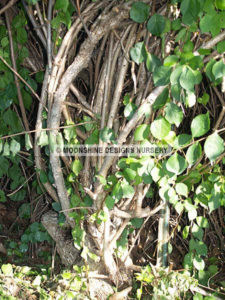
This is one of our stock plants where we obtain cuttings for propagation. It is also the vine that yielded the berry clusters shown farther down the page.
I have some plants that have one stem coming out of the ground but they split up to 2 or 3 stems before they reach the first wire. Should I prune these to one dominate stem? Limit these to two trunks and send one each way at the wires or fence. If too many stems are allowed to form before the “trunk” gains girth, it could break off in a storm.
When the main stem goes over the 5 foot mark should I cut it so it sends out two laterals or should I just send it down the wire and let it make another lateral to go the other direction? Depends on how far you want to reach to work on them. I like to top at 6′, but then I am tall. The more laterals you have, the more area there is for fruit production. Just be sure to allow space for the sun to enter! Too dense and the leaves will not be able to photosynthesize and the bees may not find all the blooms to pollinate.
I grew my plants on stakes the first year. This year, I took the plants off the stakes and untangled them and put them on the wires. Will the twisted trunks straighten out or just keep growing in a spiral? They will stay twisted, but new growth will grow straight until it finds something else to wind around. Don’t try to “un-screw” them or they may break. At the very least, it could injure the cambium layer under the bark. This is the layer that transmits the nutrients to the upper part of the plant. If this layer is broken all the way abound the stem or branch, then the upper portion will die. The inner part, or “wood” is only there to support the branch. It does not transmit any nutrients.
When is the best time to prune? Late spring, after the bloom. Vines may also be pruned just about anytime, but be careful not to prune off flowering wood. The most blooms are produced on the previous season’s growth. Old, non productive wood should be culled out in late fall each year.
HARVEST:
When is the best time to pick the berries? I am assuming you meant the best time to cut the branches. For retail sales, this can be anytime from late September on. If cut before the capsules open, they can be “forced: open by freezing for 24 hours or natural drying. For home use in decorating, wait until after the first hard frost. If cut then, they should open in 24 hours if hung in a warm place.
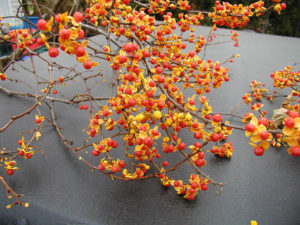
In the photo above is a branch cut from one of our female stock plants. There are ten marketable “sprigs” that can be cut. The remaining odd branches can be cut and tied as a group, or used in floral arrangements.
Should I ship the branches before they are dry, or should I dry them first? Dried branches tend to “shatter” in transit. Cut branches need to be still green and shipped to their destination with 72 hours of cutting. This is why bittersweet is so hard to find in some areas. It does not ship well after it is dry.
How long should the branches be that I cut? Six to twelve inches is the most common and these are usually tied three to a “bunch” for retail sales. Long, berried branches are in high demand by florists and crafters. These always command a premium price. They also require attention to detail during the growing season. The branch shown below sold for $75.00 in 2006.
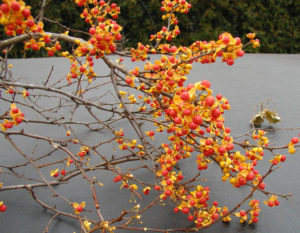
CRITTER PROBLEMS:
Will deer eat my vines? We have never seen deer eat bittersweet berries, leaves, or branches. However, deer will eat ANYTHING if hungry enough. We have seen them eat Washington Hawthorn in the dead of winter and this tree has 1″ very sharp thorns all over it! They did however, leave our bittersweet alone.
What is eating my berries!! If eaten after the capsules opened, it could be birds, rabbits, voles (see the next question), other rodents, squirrels, or grouse. These critters usually don’t bother with the berries if the capsules have not opened yet.
My vines fell over and all the roots are gone. What happened? One word: VOLES. If you have never heard of this rodent, it looks like a cross between a mole and a mouse. There are several kinds, with the most common being the Meadow Vole. The amount of destruction that these critters can do in a short time is devastating. They will eat the roots of just about ANY plant that they can get to, especially woody vines, trees, and shrubs. They will also eat all of the bark and cambium off of the lower trunk or stem as far as they can reach, girdling the plant and killing it. Their favorites are Viburnums, Willow, any member of the apple, plum, or cherry family, Arborvitae, Juniper, Yew, and Weigela. Next are Hydrangea, Sambucus (elderberry), Spirea, Euonymus (burning bush), Barberry, and Tamarix. The only plants that we have never had a problem with them eating the roots and stems off of is Forsythia and Walnut. This damage often is blamed on moles by mistake. Moles feed on insects and earthworms and do not consume plant materials.
During the summer, they will eat weeds (yes, really) and seeds, only having a few roots as a snack. If the seed head of a weed is out of reach, they will start at the bottom of the stalk and eat it into 1″ pieces until they reach the seed head, leaving a little pile of “mulch” behind. They also use these pieces to build a cone-shaped nest above ground in hidden places. Mostly, they live underground. They will use the same “beaten path” when traveling, eating off the grass, weeds, or what-ever-else is in the way. The ground nests are a give-away as they leave a pile of pea-shaped dirt pieces piled up a short distance from the entrance. Burrow entrance is about 1″ in diameter and is usually perfectly round. Vole tooth marks on trunks and stems are 1/16″ wide at are at various angles. Rabbit tooth marks are twice as large and usually all at the same angle.
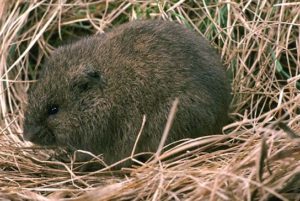
Meadow Vole
Photo courtesy of e-nature.com
The next photo is of ONE nest removed from a two gallon container-grown plant:
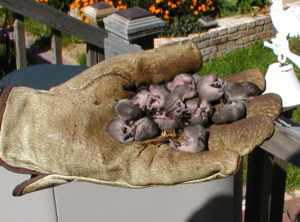
There are 14 babies.
VOLE CONTROL:
We spend over $1,000.00 a year on control using specific poisons in secure bait stations. The electronic “vole repellers” DO NOT WORK. We have also tried traps with very limited success. If using poisons, follow manufacture’s directions. DO NOT place where children, pets, or other animals can access the bait.
We are very careful not to target, by accident, any other bird or animal (except mice). Use of SECURE bait stations is a MUST!!!
Voles multiply rapidly. They do not hibernate. I don’t think they do anything but eat and breed. If a problem is found, act at once. The damage they can do in a short period is amazing. Before we noticed an infestation at the back of our nursery, they ruined 85 red contorted willow trees in 5 gallon pots with a combined value of $4,165.00 in less than two weeks. We have also had them kill an Apple tree that has a trunk diameter of 4-1/2″ by eating of all of the cambium below ground.
The University of Nebraska has a good web page dedicated to vole control here.
We rarely hype products from other companies, but here are some good control sources:
